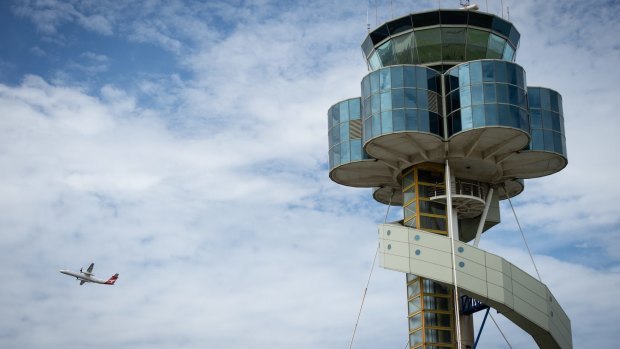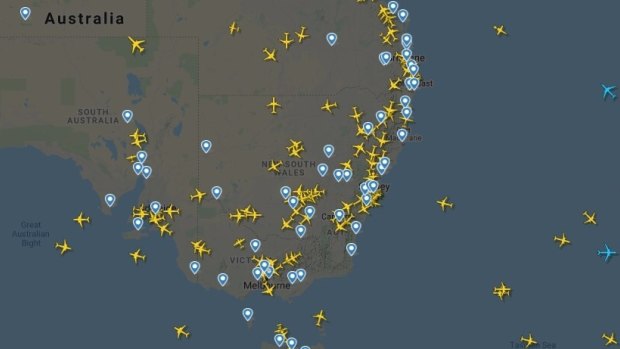This was published 2 years ago
Air traffic controllers in Australia: One of the world's most stressful jobs

The tower at Sydney Airport. Airservices Australia has proposed relocating as many as 65 air traffic controllers from Sydney to Melbourne, halving the number of controllers at Sydney Airport.Credit: Wolter Peeters
What's the most stressful job in the world? Bomb disposal expert, New Delhi taxi driver, parking inspector? You'd have to add to that list of candidates the men and women who staff airport control towers. Not that you'd know it because – Hollywood aside – what really goes on in an airport control tower looks like a standard working environment – a bunch of people wearing headsets and hunched over video monitors.
At its most basic the job of air traffic control is to maintain aircraft safety and organise air traffic to flow at maximum efficiency. That involves routing aircraft between terminal and runway, staging take-offs and landings and monitoring aircraft to ensure they maintain the required vertical and horizontal separation. Regulations require that aircraft must be vertically separated by at least 1000 feet, or 300 metres. The vertical separation can be less provided those aircraft are at least five nautical miles or nine kilometres from one another measured horizontally.
Air traffic management divides the world into a mosaic of individual airspace divisions that interlock like jigsaw pieces. Parts of that mosaic are not monitored by air traffic control, such as over some oceans, although that's changing as air traffic management transitions to a satellite-based tracking system. As an aircraft travels through monitored airspace it is tracked by the responsible air traffic controller, who might instruct the pilot to alter speed, altitude or direction.

Flights over south-eastern Australia on Sunday night.Credit: Flightradar24.com
The more traffic in a particular area, the smaller the airspace divisions become. Belgium is about one-quarter larger than Anna Creek Station, Australia's largest cattle station, yet the country is divided into four airspace divisions. In a one-hour flight from London's Heathrow to Frankfurt, an aircraft will pass through more than a dozen sectors, each one monitored by a different air traffic controller.
Air traffic control is a huge job. Hartsfield-Jackson Atlanta, the world's busiest airport, sees up to 2600 landings and departures a day. At peak time, London's Heathrow will have one aircraft arriving every 45 seconds. An air traffic controller might be monitoring up to 20 aircraft at any one time. That requires super focus, and the reason the US Federal Aviation Administration allows air traffic controllers to work for only two hours at a time without taking a break.
Australia's air traffic controllers
In Australia there are three kinds of air traffic controllers. Tower controllers clear the aircraft to land and take off. At Brisbane Airport for example the tower controller monitors an aircraft when it gets within five nautical miles of the airport and clears it for landing. They also clear aircraft for takeoff and guide the pilot onto the taxiways between the runway and terminal.
Approach controllers handle arriving and departing aircraft. In the case of Brisbane Airport, the approach controllers handle aircraft within a 30-mile radius.
En route controllers monitor the aircraft at cruise altitude, between 40,000 and 19,000 feet. They link with the approach controller, handing over the aircraft on descent and receiving the aircraft after takeoff.
Other air traffic controllers around the world also operate on a tiered system although it might differ from Brisbane Airport's. At London Heathrow, ground controllers guide the aircraft between the terminal and the runway, when tower control takes over.
As a cost-saving measure brought on by the pandemic and the reduced number of flights, Airservices Australia has proposed relocating as many as 65 air traffic controllers from Sydney to Melbourne, halving the number of controllers at Sydney Airport. That's already happened at Canberra, Gold Coast, Adelaide and Cairns airports, where terminal control services have been transferred to Melbourne and Brisbane.
Consolidation of aircraft management services is a fact of life in an era when aircraft are universally tracked and monitored from remote locations, although air traffic controllers in the tower at Sydney Airport, responsible for monitoring aircraft within a five mile radius of the airport, would not be affected.
When it all goes wrong
In July 2002 BAL Bashkirian Airlines Flight 2937, a Tupolev Tu-54 passenger jet flying from Moscow to Barcelona, collided with a DHL Boeing 757 cargo flight over the German town of Uberlingen. Forty-five of the passengers were Russian children on a school trip.
The air traffic controller responsible for the airspace at that time was Peter Nielsen, based in Zurich. Both aircraft were flying at 36,000 feet on a collision course and just 44 seconds before impact when Mr Nielsen realised the danger and instructed the Russian pilot to descend.
This was in contradiction to the aircraft's traffic collision avoidance system (TCAS) which instructed the pilot to climb, however the pilot chose to follow the traffic controller's instructions. Meanwhile, the TCAS on the cargo jet also commanded the pilot to descend. Just eight seconds before contact the Russian crew made visual contact with the DHL aircraft approaching from the port side. Despite avoidance action, collision was now unavoidable.
Crash investigators established Mr Nielsen wasn't told that an early-warning system had been switched off for repairs. The control room was understaffed, he was operating two workstations, and a second controller supposed to be on duty was asleep. A German controller who had spotted the intersecting flights earlier was unable to contact Mr Nielsen by phone.
Skyguide, the private Swiss operator responsible for supervising the airspace and Mr Nielsen's employer, initially blamed the Russian pilot for the accident but subsequently accepted full responsibility and paid compensation to the victims. In a tragic post-script, Peter Nielsen was stabbed to death at his home by a Russian architect whose wife and two children had died in the disaster.
How to listen in to air traffic controllers' communications
Live ATC gives you a feed on communications between air traffic controllers and pilots at thousands of airports around the world. It's brisk, mumbled and often hard to decipher over the static, and unless you're a total aircraft geek, not all that interesting.
For something more heart-pounding, tune into the highlights featured in Archived LiveATC Recordings. The feeds include airspace violations, busts of drug-mule aircraft, crashes with military aircraft, medical emergencies and reports of a passenger on the apron at Dublin Airport chasing after a departing Ryanair flight.
Sign up for the Traveller newsletter
The latest travel news, tips and inspiration delivered to your inbox. Sign up now.